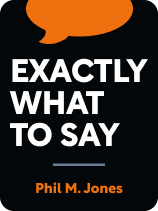

This article is an excerpt from the Shortform book guide to "Exactly What to Say" by Phil M. Jones. Shortform has the world's best summaries and analyses of books you should be reading.
Like this article? Sign up for a free trial here.
Want an overview of Phil M. Jones’s Exactly What to Say? What are the book’s key takeaways and suggestions for sales techniques?
In Exactly What to Say, Phil M. Jones describes how to improve your business interactions by using key phrases that appeal to your listener’s subconscious mind. He claims that you can guide them to a decisive “yes” by capitalizing on conversational selling skills.
Read on for an overview of the sales techniques and key phrases in Phil M. Jones’s Exactly What to Say.
Exactly What to Say Overview
Do you have a great business product and want to land new customers quickly? In Exactly What to Say, Phil M. Jones teaches you how to improve your business interactions by using key phrases that guide your listener to a decisive “yes.”
Business expert Phil M. Jones wrote Exactly What to Say to explain how using his key phrases helps you appeal to the customer’s subconscious mind, gain the upper hand in conversations, and increase your chances of making a sale. Jones’s advice is geared toward business interactions, but he notes that the principles are transferable across many industries and contexts.
Jones has been a professional salesman since he was a teenager, in industries ranging from professional soccer to real estate. He does motivational speaking events and trainings around the world to help business professionals improve their communication skills. He has written seven best-selling business books and emphasizes the quality of conversations as the key to persuading customers.
The Key to Making a Sale
The common thread in Jones’s advice for landing a sale is that all the key phrases target a subconscious tendency in the listener. Jones emphasizes that the phrases are meant to trigger a reflexive response, without the listener actively analyzing and thinking about what you’ve said. Using this tactic gets people to agree with you faster and avoids time they might otherwise spend being indecisive and critical. For example, when you tell someone, “Just imagine how happy you’ll be when you add this item to your collection,” the person automatically envisions this scenario and feels the emotion associated with it rather than focusing on a logical assessment of the purchase.
What to Say When You Introduce an Idea: Lower the Stakes & Pique Interest
Now that we’ve covered the overarching philosophy behind subconscious persuasion in Exactly What to Say, we’ll describe Phil M. Jones’s strategy for piquing interest while lowering the stakes.
Jones recommends using the phrase “Not sure if it’s for you, but…” to put your customer at ease at the beginning of the conversation. This phrase takes the pressure off of them to take your offer. By implying that it might not be a good fit, you also pique the customer’s interest, subconsciously creating a desire to find out if it’s “for them.” As an added benefit for the seller, Jones describes the phrase as “rejection-free” because the customer will either ask for more information or tell you they’ll consider it.
For example, you can say, “I’m not sure if it’s for you, but I offer a course that teaches entrepreneurship skills.” Whether or not the person was already interested, the language encourages the customer to continue the conversation because you’ve sparked their curiosity about the opportunity. In addition, because you’ve suggested that the customer’s decision could go either way, they don’t feel coerced into it.
(Shortform note: Jones claims that this phrase is “rejection-free” because at worst, the customer will tell you they’ll think about the offer. However, he doesn’t account for the possibility of someone saying, “No, I’m not interested,” and ending the conversation. The phrase, “I’m not sure if it’s for you, but…” may be effective for encouraging people to find out more information, but the statement alone doesn’t prevent a flat-out rejection.)
What to Say When Someone Is Undecided: Appeal to Emotion
The first sections focused on the concept of subconscious persuasion and what to say at the beginning of a sales pitch to increase your chance of success. Now, we’ll discuss the key phrase in Exactly What to Say that Phil M. Jones suggests using when people are still undecided during your conversation.
Because people are emotionally driven, one way to persuade an undecided customer is to leverage their natural desire to feel positive emotions and avoid negative emotions. Jones argues that when you use the phrase “How would you feel if…” you make people actually experience the emotion of the conditional scenario.
For example, you can say, “How would you feel if you bought this product, and it helped you surpass your sales goal within six months?” This language makes the customer feel a positive emotion in the context of your product and makes them believe that the described outcome is possible, motivating them to accept your offer to manifest that feeling in the future.
What to Say When Someone Has an Objection: Get More Information
The previous sections in Exactly What to Say covered what Phil M. Jones suggests you say when you introduce an idea and how to steer an undecided person toward a yes. This next section focuses on key phrases Jones recommends using when a prospective customer raises an objection to what you’re selling.
The phrase, “What makes you say that?” is an effective response to a customer’s objection because it prevents the discussion from turning into an argument and leads to more information about the other person’s needs. Instead of suggesting the customer is wrong (for example, by saying “Yes, you actually would benefit from this product.”), Jones explains that posing this question forces the person to justify their objection. The person might realize that they don’t have a strong argument for their opinion, or they could provide more transparency on their specific needs, which will help you negotiate.
For example, if a prospective customer says, “I don’t think your product is a good fit for me,” using this key phrase as a response encourages the customer to tell you why exactly they think that. With this information, you can make a stronger case for why they should buy the product.
What to Say to Capitalize on a “No” or “Yes”: Offer a Downsell
The final section in Exactly What to Say covers what to do when a customer says no—Phil M. Jones encourages using the phrase “Just one more thing…” to achieve a downsell, or the next best offer after the first deal you tried to make. Instead of walking away from the conversation with nothing, this phrase creates an opportunity to get something, even if it wasn’t your original goal.
For example, if you offer someone an expensive new software, and they reject it, you could say, “Okay, just one more thing. I have a free version of this software that also works really well. Would you be interested in trying that?” By achieving a downsell you make the conversation worthwhile.

———End of Preview———
Like what you just read? Read the rest of the world's best book summary and analysis of Phil M. Jones's "Exactly What to Say" at Shortform.
Here's what you'll find in our full Exactly What to Say summary:
- How to improve your business interactions by using key phrases
- How to appeal to your listener’s subconscious mind and guide them to a decisive “yes”
- How you can capitalize on a conversation even if a customer says "no"






